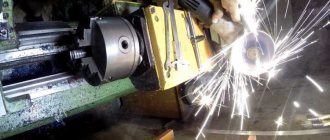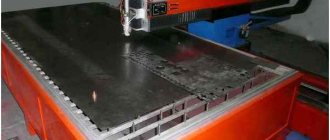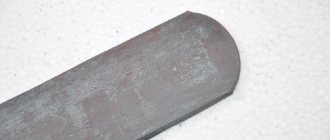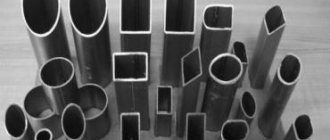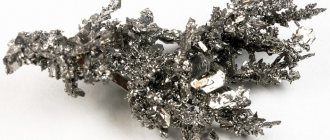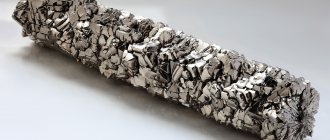Aluminum
Probably the most diverse material in terms of execution. Tourist cookware made of aluminum is stamped, cast, anodized, and coated with Teflon. The high thermal conductivity of aluminum is both an advantage and a disadvantage. Yes, the heat of a fire or burner will be distributed more quickly over the area of the cookware, and the likelihood of food burning in it is reduced. But using an aluminum mug for drinking hot drinks is very inconvenient, unless its handle is coated with silicone or wrapped in paracord, and then there is a risk of burning your lips if not your hands.
Cast aluminum is the king of fire pits. Cauldrons, pots, and frying pans made of thick metal are ideal for preparing a wide variety of dishes - from scrambled eggs to pilaf. Thanks to the thickness of the walls, the heat in such dishes is distributed as evenly as possible, which reduces the risk of food burning to a minimum. In addition, such dishes are easy to wash, both from cooking residues and from soot. Of course, cast aluminum cookware is far from the lightness of stainless steel or titanium. But in terms of resistance to damage, it is probably not inferior to anyone. In my opinion, a frying pan or saucepan made of cast aluminum can appear in a backpack, assembled with an eye to small trips and gatherings around the fire.
The cost of such dishes is average - famous outdoor brands do not produce them, but domestic manufacturers have low prices and a rich assortment.
Aluminum cookware produced by stamping is a champion in lightness. But it ranks last in terms of resistance to damage. Aluminum is a soft metal, and if in the case of casting the wall thickness helps, then in the case of stamping only anodizing helps a little. But you can no longer rub such dishes with sand - a scratched anodized pot looks completely unpresentable. Teflon and other non-stick coatings on thin-walled aluminum will be more beneficial - after all, stamped cookware distributes heat worse than cast cookware, and the risk of food burning is quite high, especially when using burners with a narrow flame.
By the way, the high thermal conductivity of aluminum is used in the production of integrated food preparation systems, with the spread of sublimates and soft canned food that came to mass tourism from mountaineering. Jet Boil became the pioneers in the implementation of such systems; now similar systems from all manufacturers of gas tourism equipment are called jetboils.
Aluminum cookware without coating is unrivaled in terms of cheapness. But the anodized one will cost about the same as its stainless steel counterpart.
Areas of use
The use of titanium depends on the degree of its purification from impurities. The presence of even a small amount of other chemical elements in the composition of a titanium alloy radically changes its physical and mechanical characteristics.
Titanium with a certain amount of impurities is called technical titanium. It has high corrosion resistance, it is a lightweight and very durable material. Its use depends on these and other indicators.
- In the chemical industry, heat exchangers, pipes of various diameters, fittings, housings and parts for pumps for various purposes are made from titanium and its alloys. The substance is indispensable in places where high strength and resistance to acids are required.
- In transport, titanium is used for the manufacture of parts and assemblies for bicycles, cars, railway cars and trains. The use of the material reduces the weight of rolling stock and cars, and gives lightness and strength to bicycle parts.
- Titanium is of great importance in the naval department. Parts and hull elements for submarines, propellers for boats and helicopters are made from it.
- The construction industry uses zinc-titanium alloy. It is used as a finishing material for facades and roofs. This very durable alloy has an important property: it can be used to make architectural parts of the most fantastic configuration. It can take any form.
- In the last decade, titanium has been widely used in the oil industry. Its alloys are used in the manufacture of equipment for ultra-deep drilling. The material is used to manufacture equipment for offshore oil and gas production.
Other techniques
There are a number of alternative ways to determine titanium in your hands or aluminum, for example. One option is thin shavings. In the case of titanium, it is highly flammable and burns brightly. On the contrary, aluminum shavings melt. When duralumin “metal filings” are placed in an alkaline solution, active evolution of hydrogen is observed.
The next way to distinguish titanium metal from steel and aluminum is thermal conductivity. The numerical values of the parameter W/(m K) for the indicated metals are:
- titanium – 14;
- low carbon steel – 55;
- stainless steel – 16;
- aluminum – 250.
Titanium products are warmer in the hands. Of course, the approach is not characterized by high accuracy, and is generally unsuitable .
Physical properties
Titanium is a lightweight silvery-white metal. At normal pressure, it exists in two crystalline modifications: low-temperature α-Ti with a hexagonal close-packed lattice (hexagonal system, space group C
6
mmc
, cell parameters
a
= 0.2953 nm,
c
= 0.4729 nm,
Z
= 2) and high-temperature β-Ti with cubic body-centered packing (cubic system, space group
Im
3
m
, cell parameters
a
= 0, 3269 nm,
Z
= 2), transition temperature α↔β 883 °C, transition heat ΔH
=
3.8 kJ/mol (87.4 kJ/kg). Most metals, when dissolved in titanium, stabilize the β-phase and reduce the temperature of the α↔β transition. At pressures above 9 GPa and temperatures above 900 °C, titanium transforms into the hexagonal phase (ω-Ti). The densities of α-Ti and β-Ti are respectively 4.505 g/cm³ (at 20 °C) and 4.32 g/cm³ (at 900 °C). The atomic density of α-titanium is 5.67⋅1022 at/cm³.
The melting point of titanium at normal pressure is 1670 ± 2 °C, or 1943 ± 2 K (adopted as one of the secondary calibration points of the ITS-90 temperature scale. Boiling point 3287 °C. At a sufficiently low temperature (-80 °C), titanium becomes quite brittle.Molar heat capacity at normal conditions Cp
= 25.060 kJ/(mol·K), which corresponds to a specific heat capacity of 0.523 kJ/(kg·K).
Heat of fusion 15 kJ/mol, heat of evaporation 410 kJ/mol. Characteristic Debye temperature 430 K. Thermal conductivity 21.9 W/(m K) at 20 °C. The temperature coefficient of linear expansion is 9.2·10−6 K−1 in the range from −120 to +860 °C. Molar entropy of α-titanium S
0 = 30.7 kJ/(mol K).
For titanium in the gas phase, enthalpy of formation Δ H
0 f = 473.0 kJ/mol, Gibbs energy Δ
G
0 f = 428.4 kJ/mol, molar entropy
S
0 = 180.3 kJ/(mol K), heat capacity at constant pressure
Cp
= 24.4 kJ/(mol K)
The electrical resistivity at 20 °C is 0.58 μOhm m (according to other data 0.42 μOhm m), at 800 °C 1.80 μOhm m. Temperature coefficient of resistance 0.003 K−1 in the range 0…20 °C.
Plastic, weldable in an inert atmosphere. Strength characteristics are little dependent on temperature, but are highly dependent on purity and pre-treatment. For technical titanium, the Vickers hardness is 790–800 MPa, the normal elastic modulus is 103 GPa, and the shear modulus is 39.2 GPa. High-purity titanium, pre-annealed in vacuum, has a yield strength of 140–170 MPa, relative elongation of 55–70%, and Brinell hardness of 716 MPa.
It has a high viscosity and, during machining, is prone to sticking to the cutting tool, and therefore requires the application of special coatings to the tool and various lubricants.
At normal temperatures it is covered with a protective passivating film of TiO2 oxide, making it corrosion resistant in most environments (except alkaline).
The transition temperature to the superconducting state is 0.387 K. At temperatures above 73 Kelvin, titanium is paramagnetic. Magnetic susceptibility at 20 °C is 3.2·10−6. The Hall constant of α-titanium is +1.82·10−13.
Isotopes
Main article: Isotopes of titanium
Known isotopes of titanium with mass numbers from 38 to 63 (number of protons 22, neutrons from 16 to 41), and 2 nuclear isomers.
Natural titanium consists of a mixture of five stable isotopes: 46Ti (isotopic abundance 7.95%), 47Ti (7.75%), 48Ti (73.45%), 49Ti (5.51%), 50Ti (5.34%) .
Among the artificial isotopes, the longest-lived are 44Ti (half-life 60 years) and 45Ti (half-life 184 minutes).
Summary
As you can see, even at home, it is quite possible to distinguish titanium from aluminum and steel. The most practical options are spark and glass . For the first case, any abrasive surface is sufficient, even asphalt or hardened concrete. The bright sparkle of titanium is successfully used by bikers by installing horseshoes made of this metal on their shoes. The mark on the glass is beneficial because the metal is not damaged. A relative disadvantage is that some titanium alloys do not leave a pattern. But for pure metal this is the best option.
Determination by mass
The lightest of these three metals is aluminum, the heaviest is steel. For example, a titanium plate will be one and a half times heavier than an aluminum one and two times lighter than a steel one. If there is nothing to compare the sample with, then you will have to use a mathematical method. The density of the metals in question is known to us and is:
- for titanium – 4.5 g/cm³
- for aluminum – 2.7 g/cm³
- for stainless steel 7.8 g/cm³
This is the mass per unit volume. All that remains is to weigh the product on precise scales and determine its volume. If the product has a complex shape, then it is easier to find out the volume using the Archimedean method. Dip the sample into a container of water and determine the required value by the volume of water displaced. All that remains is to calculate the density by dividing the mass by the volume, and then check whether it corresponds to the density of titanium.
Drawings on glass
This is the most accessible method of how to distinguish titanium at home, but you need to master it and have experience working with titanium. Metal leaves characteristic indelible marks on glass and tiles . It is enough to run the sharpened edge of the metal along one of the specified materials. These are marks, not scratches. Windows of public transport are often painted in a similar way. You can wash titanium graphics on tiles with a solution of hydrofluoric acid; you should handle it with extreme caution.
This method is simple and effective. Titanium, contrary to popular belief, leaves a mark even on dirty glass. So there is no need to degrease its surface. On the contrary, any grade of steel and aluminum can barely scratch the glass. This is an excellent method to identify titanium.
Anodizing test
It is known that as a result of natural oxidation in air, a layer of TiO2 oxide is formed on the surface of titanium. By electrochemical method it is possible to obtain an oxide layer with a coloring effect. To carry out the experiment, you need a 12-volt car battery or several Krona batteries. The titanium sample is connected with a wire to the “+” electrode. Any iron rod wrapped in a piece of cloth soaked in saline solution or any other conductive liquid (vinegar, cola) is connected to the “-” electrode. If you run this cloth over a titanium surface, it will instantly become colored, which will never happen with stainless and aluminum products.
There are a number of other testing methods that allow us to distinguish real titanium from other metals that surround us in everyday life. For example, titanium objects seem warmer upon tactile contact. If you heat one part of the part, the other will remain cold, which indicates its low thermal conductivity. Cutting titanium is much more difficult than other metals. Material particles stick to the blade, making cutting unstable and unsafe. To accurately determine titanium, it is recommended to carry out not one, but several methods.
Methods of obtaining
Titanium is one of the most abundant elements on Earth. Its content in the bowels of the planet by mass is 0.57%. The highest concentration of the metal is observed in the “basalt shell” (0.9%), in granitic rocks (0.23%) and in ultramafic rocks (0.03%). There are about 70 titanium minerals in which it is found in the form of titanic acid or dioxide. The main minerals of titanium ores are: ilmenite, anatase, rutile, brookite, loparite, leucoxene, perovskite and sphene. The world's main titanium producers are the UK, USA, France, Japan, Canada, Italy, Spain and Belgium. There are several ways to obtain titanium. All of them are used in practice and are quite effective.
Magnesium-thermal process.
Ore containing titanium is mined and processed into dioxide, which is slowly and at very high temperatures subjected to chlorination. Chlorination is carried out in a carbon environment. The titanium chloride formed as a result of the reaction is then reduced with magnesium. The resulting metal is heated in vacuum equipment at high temperature. As a result, magnesium and magnesium chloride evaporate, leaving titanium with many pores and voids. Titanium sponge is melted down to produce high-quality metal.
Calcium hydride method.
First, titanium hydride is obtained, and then it is separated into its components: titanium and hydrogen. The process occurs in an airless space at high temperatures. Calcium oxide is formed, which is washed with weak acids. Calcium hydride and magnesium-thermal methods are commonly used on an industrial scale. These methods make it possible to obtain a significant amount of titanium in a short period of time, with minimal monetary costs.
Electrolysis method.
Titanium chloride or dioxide is exposed to high current. As a result, the compounds decompose.
Iodide method.
Titanium dioxide reacts with iodine vapor. Next, titanium iodide is exposed to high temperature, resulting in titanium. This method is the most effective, but also the most expensive. Titanium is obtained of very high purity without impurities or additives.
Methods of obtaining
Titanium is one of the most abundant elements on Earth. Its content in the bowels of the planet by mass is 0.57%. The highest concentration of the metal is observed in the “basalt shell” (0.9%), in granitic rocks (0.23%) and in ultramafic rocks (0.03%). There are about 70 titanium minerals in which it is found in the form of titanic acid or dioxide. The main minerals of titanium ores are: ilmenite, anatase, rutile, brookite, loparite, leucoxene, perovskite and sphene. The world's main titanium producers are the UK, USA, France, Japan, Canada, Italy, Spain and Belgium. There are several ways to obtain titanium. All of them are used in practice and are quite effective.
Magnesium-thermal process.
Ore containing titanium is mined and processed into dioxide, which is slowly and at very high temperatures subjected to chlorination. Chlorination is carried out in a carbon environment. The titanium chloride formed as a result of the reaction is then reduced with magnesium. The resulting metal is heated in vacuum equipment at high temperature. As a result, magnesium and magnesium chloride evaporate, leaving titanium with many pores and voids. Titanium sponge is melted down to produce high-quality metal.
Calcium hydride method.
First, titanium hydride is obtained, and then it is separated into its components: titanium and hydrogen. The process occurs in an airless space at high temperatures. Calcium oxide is formed, which is washed with weak acids. Calcium hydride and magnesium-thermal methods are commonly used on an industrial scale. These methods make it possible to obtain a significant amount of titanium in a short period of time, with minimal monetary costs.
Electrolysis method.
Titanium chloride or dioxide is exposed to high current. As a result, the compounds decompose.
Iodide method.
Titanium dioxide reacts with iodine vapor. Next, titanium iodide is exposed to high temperature, resulting in titanium. This method is the most effective, but also the most expensive. Titanium is obtained of very high purity without impurities or additives.
Abrasive wheel
An ideal way to distinguish titanium from stainless steel for owners of a sharpening machine (which, in fact, is not at all necessary). However, almost any abrasive surface will do, even asphalt. The contact of titanium with an abrasive is accompanied by a scattering of rich white sparks. The interaction of steel with an abrasive surface is characterized by a yellow or red tint. There are significantly fewer sparks.
Stainless steel grades are fireproof. Processing of certain brands of stainless steel occurs without sparks at all. This property is used in fire hazardous industries. Only stainless steel tools are allowed there. A similar technique is used in the question of how to distinguish titanium from aluminum. Grinding of the latter on an abrasive wheel also occurs practically without sparks.
This method of determining titanium can be called the most effective - the color of the spark will indeed be different from other metals. In general, the spark test is one of the most popular and correct for determining and recognizing different metals.
Video - how to distinguish titanium from magnesium and aluminum:
Identification by mark on glass
This method is the easiest and is based on the ability of titanium to stick to glass during friction, that is, you can draw with it. The same effect is observed when running a sharp edge over a smooth tile, which is due to the high coefficient of friction of pure titanium. If stainless steel scratches a glass surface, then, to your great surprise, this hard metal does not damage the glass, but leaves a characteristic metallic mark on it, which can only be washed off with very strong hydrofluoric acid. Aluminum cannot damage glass or paint on it. It should also be noted that some titanium alloys also do not leave a pattern.
How can you tell if a piece of jewelry is made of titanium?
A distinctive feature of titanium is its ability to leave a noticeable, dark silver mark on glass, and often on earthenware or other glazed surfaces. If the resulting strip is quite indistinct, then try to clean or degrease the glass and try again.
Interesting materials:
What does the word silence mean? What does the word trash mean in youth slang? What does the word trigger mean? What does the word Cerberus mean? What does the word vulnerable mean? What does the word urbanization mean? What does the word Urkaganskoe mean? What does the word important mean? What does the word virtual mean? What does the word inclusive mean?
Pure mathematics
In this approach, metal identification is done by weight. The disadvantage of the method occurs when only one type of metal is available . To determine in your hands that it cannot be made heavier, you have to resort to mathematical calculations. This is facilitated by significant differences in the density of metals:
- titanium – 4.5;
- iron – 7.8;
- aluminum and duralumin – 2.7.
To use this method for determining titanium in your household, you need to have accurate scales.
Parameter values are given in g/cc. It remains to add that the density of steel depends on the specific grade of metal. However, in absolute terms these differences are insignificant. Therefore, the density of steel can be safely taken as the value of a similar characteristic of iron.
All that remains is to clarify the volume and weight of the part or piece of metal. Further, simple calculations will show whether it is aluminum, steel or the desired metal – titanium. How to determine the volume of a part with a complex shape? The best option here is Archimedes' law. The mass of the ejected liquid, when immersing a metal structure, allows you to determine its volume. The situation is simplified by the density of water, equivalent to 1 kg/cubic dm. Accordingly, each gram of ejected liquid is equal to one cubic centimeter of volume.
